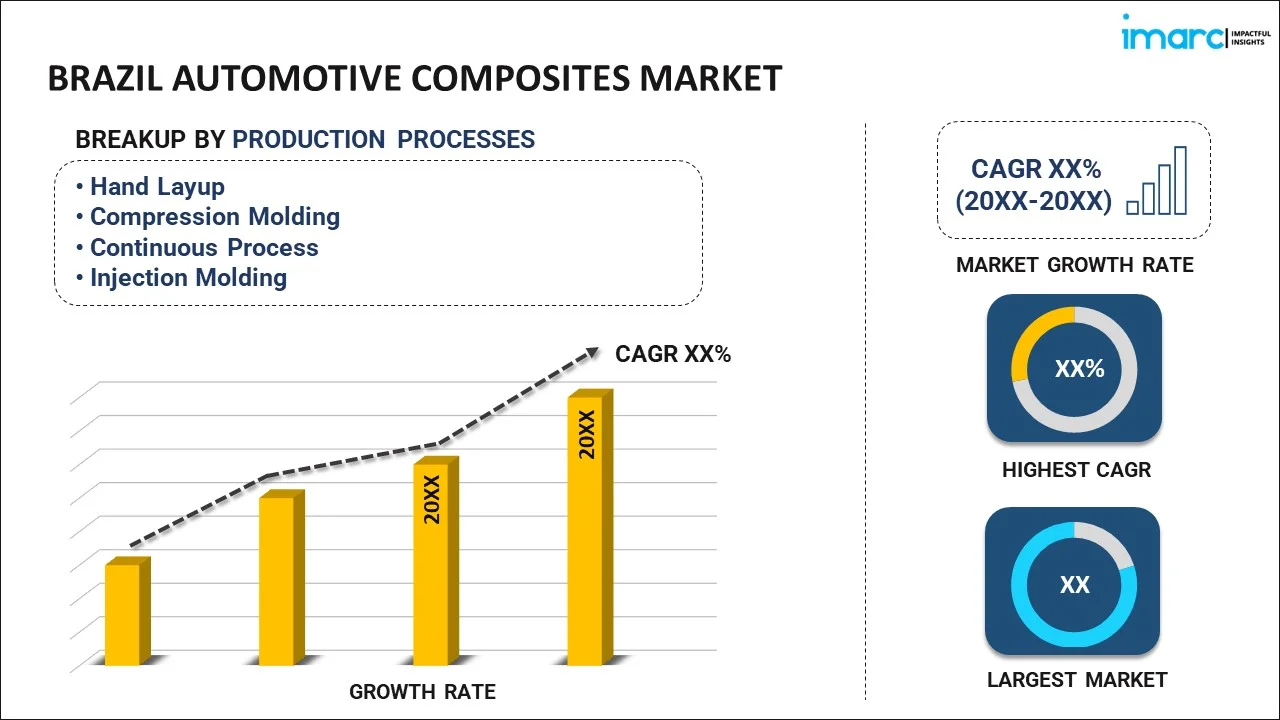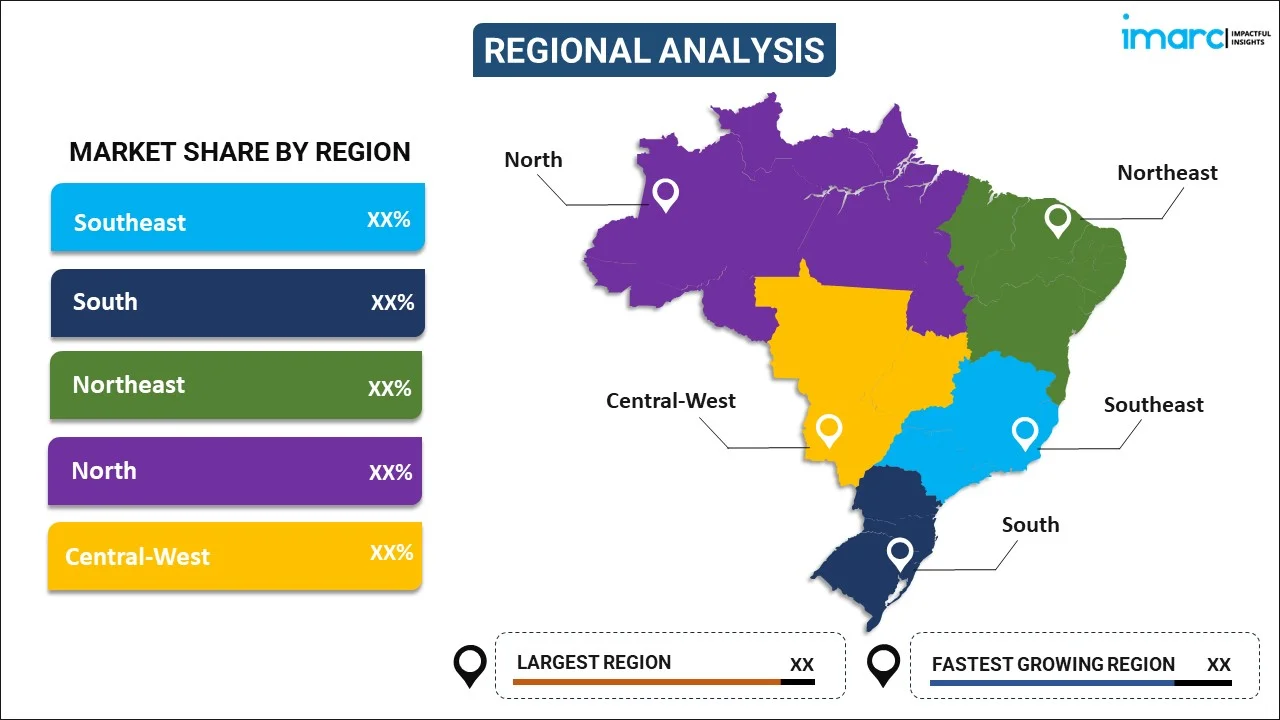
Brazil Automotive Composites Market Report by Production Process (Hand Layup, Compression Molding, Continuous Process, Injection Molding), Application (Structural Assembly, Powertrain Component, Interior, Exterior, and Others), Material (Thermoset Polymer, Thermoplastic Polymer, Carbon Fiber, Glass Fiber), and Region 2025-2033
Market Overview:
Brazil automotive composites market size reached USD 600.7 Million in 2024. Looking forward, IMARC Group expects the market to reach USD 1,692.7 Million by 2033, exhibiting a growth rate (CAGR) of 12.2% during 2025-2033. The Implementation of stringent fuel efficiency mandates, rising demand for lightweight materials, and extensive collaborative industry efforts to enhance composite applications in vehicles represent some of the key factors driving the market.
|
Report Attribute
|
Key Statistics
|
|---|---|
|
Base Year
|
2024 |
|
Forecast Years
|
2025-2033
|
|
Historical Years
|
2019-2024
|
| Market Size in 2024 | USD 600.7 Million |
| Market Forecast in 2033 | USD 1,692.7 Million |
| Market Growth Rate (2025-2033) | 12.2% |
Automotive composites refer to materials used in the construction of automobile components that are composed of two or more distinct materials with different physical and chemical properties. These materials are strategically combined to create structures that offer superior performance, weight savings, and durability compared to traditional automotive materials like steel and aluminum. The main components of automotive composites include fibers, including carbon fiber, glass fiber, or natural fibers, and matrix material, usually polymer resin, such as epoxy, polyester, or thermoplastic. These components are combined through processes like molding, layering, and curing to form composite materials with exceptional strength-to-weight ratios. The resulting composites can be used in various automotive applications, including body panels, chassis, interior parts, and drivetrain components. They are significantly lighter than traditional materials, offer excellent corrosion resistance, and exhibit high tensile strength. These properties can help improve fuel efficiency, reduce emissions, and make them suitable for various weather conditions, crash safety, and structural integrity. Composites allow for greater design flexibility, enabling automakers to create innovative, aerodynamic shapes.
Brazil Automotive Composites Market Trends:
Automotive composites potential to revolutionize vehicle design and contribute to more sustainable, efficient, and safer automobiles represents one of the key factors propelling the market growth. Besides this, stringent government regulations to improve fuel efficiency and reduce emissions have led automotive manufacturers to seek lightweight materials like composites, creating a favorable outlook for market expansion. This trend aligns with Brazil's commitment to environmental sustainability and its desire to decrease the carbon footprint of its transportation sector, further driving the adoption of composites. Moreover, the increasing consumer demand for safer and more fuel-efficient vehicles has propelled automakers to explore innovative materials like composites to enhance crashworthiness and reduce vehicle weight, strengthening the market growth. Concurrent with this, the growing consumer demand for advanced, environmentally friendly automobiles has led to a surge in research and development (R&D) efforts focused on incorporating composites into various vehicle components, aiding in market expansion. Additionally, Brazil's booming automotive industry has seen significant investments in manufacturing facilities and technologies. As a result, the infrastructure and capabilities required to produce automotive composites have expanded, making it more accessible and cost-effective for automakers to integrate these materials into their vehicles, thus contributing to the market growth. Furthermore, increasing partnerships and collaborations between automotive manufacturers, composite material suppliers, and research institutions are impelling the market growth. Apart from this, the escalating consumer awareness regarding the benefits of composites is prompting automakers to emphasize the use of composites as a selling point and as a symbol of advanced technology, safety, and environmental responsibility, which, in turn, is propelling the market forward.
Brazil Automotive Composites Market Segmentation:
IMARC Group provides an analysis of the key trends in each segment of the market, along with forecasts at the country level for 2025-2033. Our report has categorized the market based on production process, application, and material.
Production Process Insights:

- Hand Layup
- Compression Molding
- Continuous Process
- Injection Molding
The report has provided a detailed breakup and analysis of the market based on the production process. This includes hand layup, compression molding, continuous process, and injection molding.
Application Insights:
- Structural Assembly
- Powertrain Component
- Interior
- Exterior
- Others
A detailed breakup and analysis of the market based on the application have also been provided in the report. This includes structural assembly, powertrain component, interior, exterior, and others.
Material Insights:
- Thermoset Polymer
- Thermoplastic Polymer
- Carbon Fiber
- Glass Fiber
The report has provided a detailed breakup and analysis of the market based on the material. This includes thermoset polymer, thermoplastic polymer, carbon fiber, and glass fiber.
Regional Insights:

- Southeast
- South
- Northeast
- North
- Central-West
The report has also provided a comprehensive analysis of all the major regional markets, which include Southeast, South, Northeast, North, and Central-West.
Competitive Landscape:
The market research report has also provided a comprehensive analysis of the competitive landscape in the market. Competitive analysis such as market structure, key player positioning, top winning strategies, competitive dashboard, and company evaluation quadrant has been covered in the report. Also, detailed profiles of all major companies have been provided.
Brazil Automotive Composites Market Report Coverage:
| Report Features | Details |
|---|---|
| Base Year of the Analysis | 2024 |
| Historical Period | 2019-2024 |
| Forecast Period | 2025-2033 |
| Units | Million USD |
| Scope of the Report | Exploration of Historical and Forecast Trends, Industry Catalysts and Challenges, Segment-Wise Historical and Predictive Market Assessment:
|
| Production Processes Covered | Hand Layup, Compression Molding, Continuous Process, Injection Molding |
| Applications Covered | Structural Assembly, Powertrain Component, Interior, Exterior, Others |
| Materials Covered | Thermoset Polymer, Thermoplastic Polymer, Carbon Fiber, Glass Fiber |
| Regions Covered | Southeast, South, Northeast, North, Central-West |
| Customization Scope | 10% Free Customization |
| Post-Sale Analyst Support | 10-12 Weeks |
| Delivery Format | PDF and Excel through Email (We can also provide the editable version of the report in PPT/Word format on special request) |
Key Questions Answered in This Report:
- How has the Brazil automotive composites market performed so far and how will it perform in the coming years?
- What has been the impact of COVID-19 on the Brazil automotive composites market?
- What is the breakup of the Brazil automotive composites market on the basis of production process?
- What is the breakup of the Brazil automotive composites market on the basis of application?
- What is the breakup of the Brazil automotive composites market on the basis of material?
- What are the various stages in the value chain of the Brazil automotive composites market?
- What are the key driving factors and challenges in the Brazil automotive composites?
- What is the structure of the Brazil automotive composites market and who are the key players?
- What is the degree of competition in the Brazil automotive composites market?
Key Benefits for Stakeholders:
- IMARC’s industry report offers a comprehensive quantitative analysis of various market segments, historical and current market trends, market forecasts, and dynamics of the Brazil automotive composites market from 2019-2033.
- The research report provides the latest information on the market drivers, challenges, and opportunities in the Brazil automotive composites market.
- Porter's five forces analysis assist stakeholders in assessing the impact of new entrants, competitive rivalry, supplier power, buyer power, and the threat of substitution. It helps stakeholders to analyze the level of competition within the Brazil automotive composites industry and its attractiveness.
- Competitive landscape allows stakeholders to understand their competitive environment and provides an insight into the current positions of key players in the market.
Need more help?
- Speak to our experienced analysts for insights on the current market scenarios.
- Include additional segments and countries to customize the report as per your requirement.
- Gain an unparalleled competitive advantage in your domain by understanding how to utilize the report and positively impacting your operations and revenue.
- For further assistance, please connect with our analysts.
 Inquire Before Buying
Inquire Before Buying
 Speak to an Analyst
Speak to an Analyst
 Request Brochure
Request Brochure
 Request Customization
Request Customization




.webp)




.webp)












